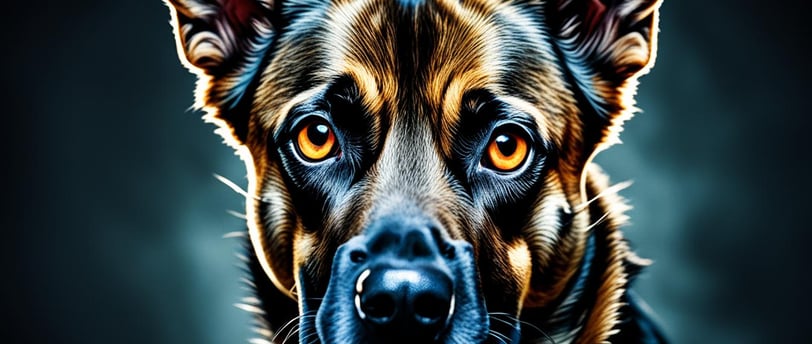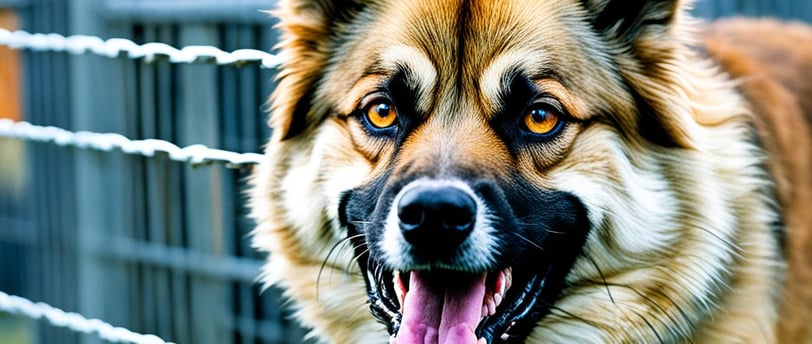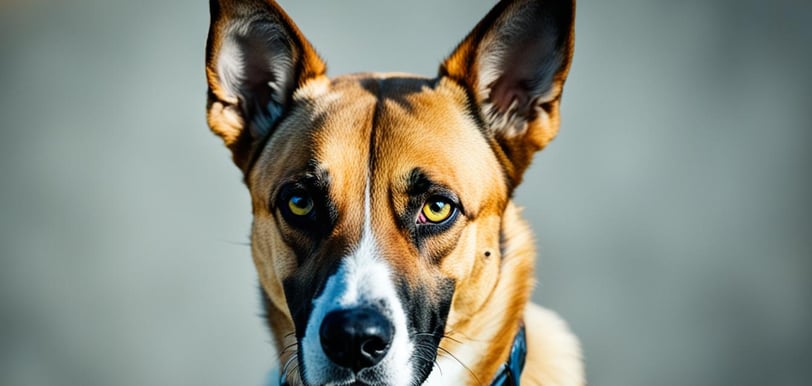Aggressive Dog Eye Contact: Understanding Canine Behavior
In "Aggressive Dog Eye Contact: Understanding Canine Behavior," we explore the significance of eye contact in dogs, particularly when it signals aggression. Learn to interpret your dog's body language, identify potential triggers, and discover effective strategies to manage aggressive behavior, ensuring a safer and more harmonious environment for you and your pet.
The Canine Chronicles
7/23/20245 min read


Have you ever felt a chill when your dog looks at you with an intense gaze?
Eye contact can mean affection for some dogs, but for others, it warns of aggression. It's key for pet owners to know the difference.
We'll look into what those deep stares mean, how to read your dog's body language, and how to handle aggressive behavior.
Key Takeaways
Aggressive dog eye contact can be a warning sign of potential aggression or dominance in canines.
Direct eye contact and pupil dilation are common signs of aggression in dogs.
Understanding your dog's body language is crucial for identifying and responding to aggressive behavior.
Proper training and management techniques can help prevent and defuse tense situations with dogs.
Being aware of your own body language and demeanor is important when interacting with dogs, especially unfamiliar ones.
What is Aggressive Dog Eye Contact?
Making eye contact with a dog can be tricky. Some see it as a way to connect, but for many dogs, it's seen as a challenge or threat. It's key to know how aggressive dog eye contact works to keep everyone safe.
Direct Eye Contact as a Threat
Dogs are very aware of body language and social signals. They might see long eye contact from a human as dominance. This can make them act defensively or aggressively, trying to protect themselves. It's best not to stare at a dog you don't know, as they might see it as a challenge.
Pupil Dilation and "Whale Eye"
When dogs feel stressed or scared, their pupils get bigger. This means they're ready to defend themselves. Another sign of stress is the "whale eye," where you see the white part of the eye in a crescent shape. This shows they're avoiding eye contact and might be feeling anxious.
https://youtube.com/watch?v=IsIJCCDI8Wg
Knowing how dogs show aggressive eye contact is key to safe and positive interactions. By paying attention to their body language and respecting their space, we can build trust and respect with our dogs.
Aggressive Dog Eye Contact: Understanding Canine Behavior
As a dog owner or someone who often meets dogs, knowing about aggressive dog eye contact is key. This behavior is a big part of how dogs talk to each other and us. It tells us a lot about their feelings and if they might act out.
When dogs stare at each other, they see it as a challenge or threat. A dog staring at you for a long time might be showing aggression or wanting to be the boss. Also, how big a dog's pupils are can tell us how it feels inside.
Pupil dilation, or "whale eye," means the dog is very excited or scared.
Knowing how dogs show aggression or excitement through their eyes helps us understand them better. This can stop fights or attacks before they start. It also helps us have better times with our dogs.
If a dog is staring aggressively, stay calm and act submissive. Don't look back at it and keep your body relaxed. This can make the dog think you're not a threat.
"Understanding dog body language, including aggressive eye contact, is essential for preventing and defusing potentially dangerous situations. By recognizing these subtle cues, we can foster safer and more positive interactions with our four-legged friends."
In dog training and behavior, knowing about aggressive eye contact is very important. Using this knowledge helps us understand dogs better. It lets us keep everyone safe and happy.


Dealing with Aggressive Eye Contact
For Dog Owners
As a dog owner, knowing about aggressive eye contact is key. You should take steps to manage it. This means training your dog with positive reinforcement. Also, watch out for situations that might make them feel threatened and act out.
If your dog shows aggressive eye contact, like a fixed stare or dilated pupils, act fast. Remove them from the situation to prevent things from getting worse. This keeps everyone safe.
After calming your dog down, get help from a pro. A trainer or behaviorist can create a plan to fix the aggressive eye contact. They'll teach your dog better ways to communicate and interact.


By acting early and getting expert help, you can help your dog stop aggressive eye contact. This will improve your bond with your dog.
Conclusion
Aggressive dog eye contact is complex and needs careful understanding and management. Recognizing signs like direct eye contact, pupil dilation, and "whale eye" helps prevent conflicts. This knowledge lets people handle these situations better and keep everyone safe.
Knowing why dogs show aggressive eye contact is key. It could be dominance, fear, or other reasons. With the right training, socialization, and clear rules, dogs and their owners can get along better. This makes everyone safer.
It's important to watch the dog's body language and act fast to calm things down. Putting the well-being of humans and dogs first helps make a positive space. Here, everyone respects and understands each other.
FAQ
What is aggressive dog eye contact?
Aggressive dog eye contact is a way dogs communicate. It includes direct eye contact, dilated pupils, and the "whale eye" look. These signs warn of possible aggression or dominance.
How can I recognize aggressive dog eye contact?
Look for direct, long eye contact, dilated pupils, and the "whale eye" where the white eye shows in a crescent shape. These are signs of aggressive behavior.
Why is understanding aggressive dog eye contact important?
It's key for dog owners and those meeting new dogs. It helps spot signs of aggression or dominance. This way, you can act to prevent fights or attacks.
How should I respond to aggressive dog eye contact?
If a dog shows aggressive eye contact, stay calm and act submissive. Avoid eye contact to calm the situation and encourage positive behavior.
What should dog owners do to manage aggressive eye contact in their pets?
Owners should know about aggressive eye contact and manage it. Use positive reinforcement to teach the dog good eye contact habits. Also, avoid situations that might make the dog aggressive.
Source Links
Thanks and best regards
The Canine Chronicles
Click the link below for a free ebook to train your dogs brain!
This post may contain affiliate links. If you make a purchase through one of these links, we may earn a small commission at no additional cost to you. We only recommend products and services that we have personally used and believe will add value to our readers. Your support helps us continue to provide valuable content. Thank you for your support!
